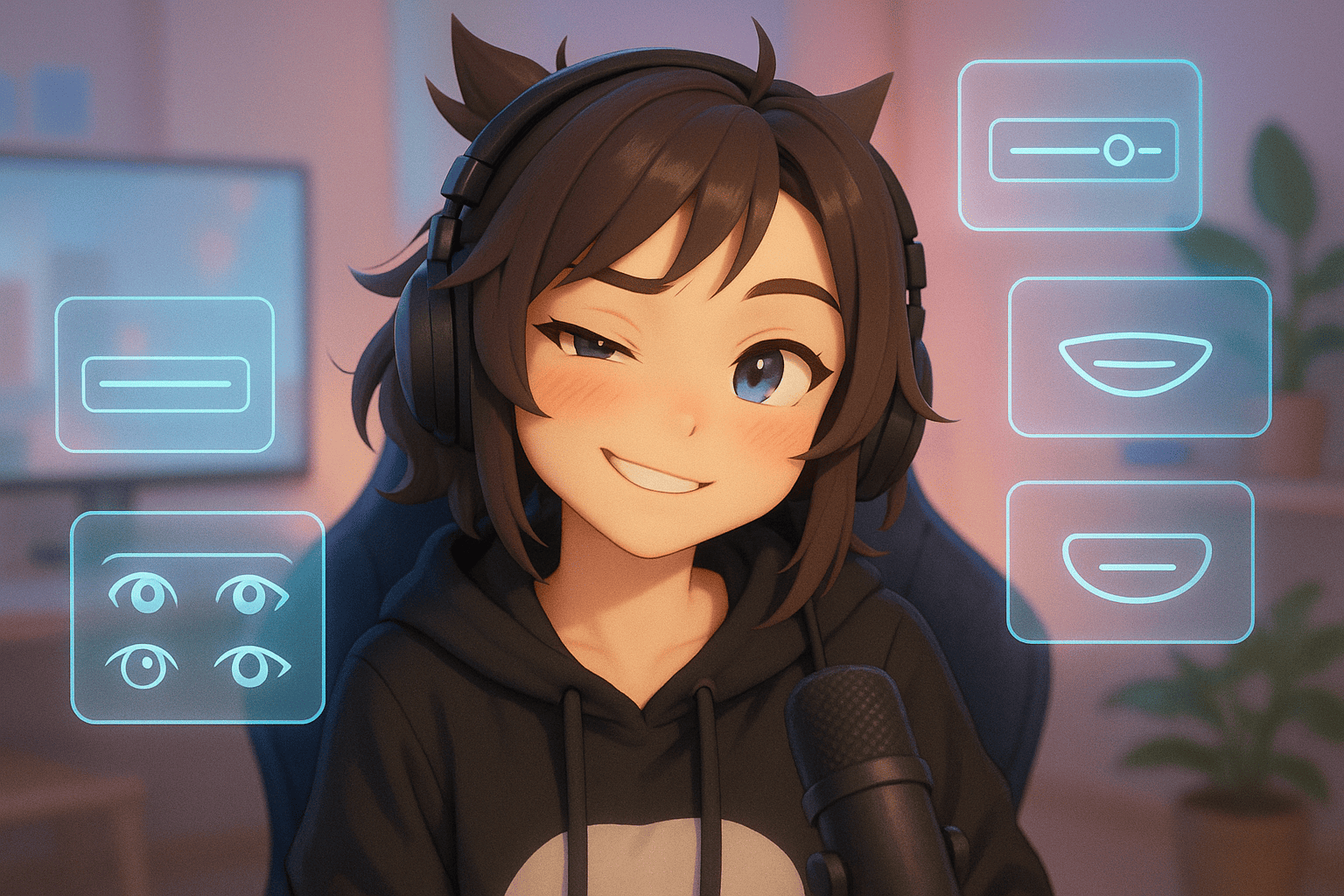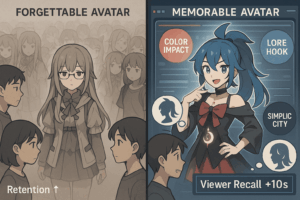Let’s face it, VTubing has evolved. We’re long past the days when blinking and smiling were enough to charm an audience. In 2025, viewers crave avatars that feel alive, ones that can frown in frustration, glance sideways in doubt, or break into a mischievous grin mid-stream. A static face won’t hold attention anymore. That’s where layered expressions step in as a game-changer for your VTuber avatar.
Creating a convincing performance is no longer about just having a high-quality VTuber model; it’s about how real that model can feel. That realism comes from emotion. From subtle changes in brows and eyes to the way a smirk forms at just the right comedic pause. In this blog, we’ll break down how to use layered expressions effectively, how they integrate with your visual identity, and why they’re essential for VTuber branding in 2025.
Why Layered Expressions Matter for Your VTuber Avatar in 2025?
Layered expressions are the secret sauce behind avatar realism. These are not just single-trigger animations like “smile” or “angry” but instead involve stacking different facial components, brows, eyelids, mouth shapes, and head tilts to create dynamic, context-driven expressions.
Picture this: You’re reacting to a plot twist in a game. Instead of switching to a pre-set “shocked” face, your VTuber avatar subtly raises one brow, eyes widen slightly, and mouth parts open. The result? Your viewers feel you’re reacting in real-time, not just toggling a cartoon filter. That kind of nuance builds immersion, and immersion builds loyalty.
How Layered Expressions Work Inside a VTuber Avatar?
Before you start building emotional depth into your content, it helps to understand the building blocks of layered expressions and how they function inside a VTuber avatar.
At the core, layered expressions break facial motion into modular parts. These include:
- Eyebrow movement (arched, furrowed, asymmetrical raises)
- Eye shape (wide open, squinted, sleepy, blinked)
- Pupil direction (left, right, focused, distracted)
- Mouth movement (smirk, pout, neutral, open with emotion)
- Cheek and blush overlays (for warmth, embarrassment, or intensity)
- Head tilts and micro-movements (that convey curiosity or surprise)
Each of these can be activated independently or stacked together, allowing for complex, nuanced expressions that evolve dynamically during a stream. Instead of relying on a flat preset face, you can fine-tune emotions in real time, layering surprise with a smirk, or frustration with a skeptical glance.
It’s not just about your VTuber model looking good; it’s about your VTuber avatar feeling alive. Layered expressions are what transform a digital character into an emotionally responsive extension of you on screen.
Setting Up Layered Expressions in Your VTuber Avatar
If you’re using software like VTube Studio, Animaze, or Luppet, you’ll find that most modern VTuber rigging supports expression layering via blend shapes or parameter toggles. But here’s where most VTubers go wrong: they don’t design for layering from the start.
Here’s how to build a rig that supports dynamic expressions:
1. Design with Layers in Mind
When creating or commissioning your VTuber avatar, ensure that:
- Your rigger includes separate parameters for facial features (e.g., brow L/R, eye L/R, mouth forms)
- There’s enough range in your mouth and eye shapes to blend for subtle shifts
- You use independent toggles for accessories (like glasses, blush, tears) that support emotional storytelling
2. Map Expressions to Real Inputs
Modern face-tracking software can detect nuanced real-time muscle movement. But you can also use hotkeys, MIDI devices, or stream decks to trigger emotional layers based on your content’s rhythm.
Pro Tip: Map simple reactions (like a slow blink + eyebrow raise + smirk) to a single keybind. These combo triggers can sell a joke or reaction better than static emotes.
3. Blend, Don’t Flip
Don’t just switch from “happy” to “sad”, blend between emotions. A twitch of the brow, a gradual eye drop, and a soft mouth curve say far more than a full face swap. This creates fluid VTuber animation that feels natural, not robotic.
Performance Tips: Using Expressions to Tell a Story
Your VTuber avatar is more than a digital puppet; it’s your virtual self. Here’s how to use layered expressions to create a stronger on-screen presence:
Use Subtlety for Suspense: In dramatic or gaming content, try layering minimal movement, eyes darting sideways, a slight frown, tight lips. These minimal cues can convey anxiety, suspicion, or surprise far better than an exaggerated shocked face.
Build Emotional Arcs in Conversation: Whether you’re telling a story, reacting to chat, or sharing a memory, layer your expressions to rise and fall with your words. Start with a neutral face, slowly layer in blush, eye sparkle, and smile as the tone lifts.
Create Signature Reactions: Just like IRL streamers have signature catchphrases or gestures, you can design signature expression combos. Maybe your mischievous face includes a smirk, one eyebrow raised, and a specific head tilt. Use it consistently, and it becomes part of your VTuber branding.
Designing a Cohesive VTuber Avatar with Expression Layers
This is where many creators miss an opportunity. Facial expression layers aren’t just technical; they’re part of your VTuber branding. Your expressions should feel like they belong to your VTuber avatar, visually and emotionally.
🔸 Match Expressions to Avatar Color Theory
If your avatar’s color palette is soft and pastel, intense facial changes can feel off-tone. Use layered expressions with gentle curves and blushing overlays. For dark, edgy avatars, go bold with wide eyes and high-contrast lighting when expressing emotion.
🔸 Keep Consistency in Personality
If your character is supposed to be calm and mysterious, don’t spam kawaii sparkly eyes every time something funny happens. Use design tips to build emotional consistency. It’ll make your character customization feel intentional, not chaotic.
🔸 Use Accessories as Expression Layers
Don’t overlook the power of accessories! Glitches, emoji overlays, floating symbols, or even lighting shifts can act as expression layers. These are subtle ways to communicate emotion without changing the base model—perfect for shy or “cool” VTuber characters.
The Performance-Design Feedback Loop
Here’s something advanced VTubers realize: expression design is a loop. You perform with your VTuber avatar, learn what works, then redesign or fine-tune layers for better delivery.
So after a few weeks of streaming with new expressions:
- Watch your VODs: which expressions felt real? Which ones were too stiff?
- Ask chat or mods: what reactions do they notice most?
- Iterate: tweak eyebrow angles, timing, or layering order
This kind of performance-refinement loop is what separates VTubers who “just look good” from ones who are memorable personalities.
Advanced Use: Emotional Color Grading in VTubing
If you want to truly push realism, you can combine facial expression layers with scene-based palette design, like an emotional LUT (look-up table) system for avatars. Let’s say your stream is entering a serious moment. Along with a sad expression, your VTuber avatar’s color grading subtly cools, shadows deepen, and blush fades. When tension breaks, warm colors return and eyes sparkle.
Tools like OBS shaders or integrated plugins let you direct not just expressions, but mood, live. You’re not just reacting anymore, you’re producing a virtual performance in real time.
What Brings Realism to a VTuber Avatar in 2025?
It’s not just a question of tracking quality anymore. The natural feel of a VTuber avatar comes from the intentional layering of personality, design, and motion. Realism now depends on:
✅ Thoughtful Facial Expression Layers
First, design facial layers that reflect real emotions. Then, stack them to create nuanced, lifelike reactions.
✅ Smart Emotional Triggers and Blending
Next, assign smart triggers to shift between moods smoothly. As a result, your VTuber avatar feels emotionally aware.
✅ Harmonizing Expressions with Your Visual Identity
Meanwhile, align expressions with your brand’s tone and style. This ensures consistency across your VTuber avatar’s presence.
✅ Performance That Evolves Based on Feedback
As you grow, adapt expressions based on viewer input. In turn, your avatar’s performance becomes more relatable and real.
✅ Expression-Driven Storytelling and Audience Connection
Finally, use layered expressions to enhance your storytelling. Therefore, your audience forms a deeper emotional connection.
These aren’t just nice-to-haves, they’re part of what makes a VTuber feel genuinely alive on screen. Realism isn’t about tricking the eye; it’s about earning the viewer’s emotional trust. When your avatar winces just before a punchline or tilts its head at just the right pause, it deepens the impact. Remember, your VTuber avatar is not just your face; it’s your brand, your acting mask, and your emotional amplifier. It should react like you, feel like you, and reflect your intent in real time.
The more you invest in that realism, through layered expressions, emotional nuance, and consistent visual storytelling, the more human your digital presence becomes in a saturated, competitive VTubing space.
The Future of Layered Expressions in VTuber Avatars
The next evolution of VTuber avatars will go beyond facial tracking. With advances in AI, emotion recognition, and real-time mocap, layered expressions will become more intuitive and emotionally intelligent. Your avatar could respond automatically to your tone, chat mood, or even biometric cues, no hotkeys required.
Expression layering is becoming the emotional language of VTubing, not just a visual upgrade. If you’re serious about standing out, now’s the time to master it. Because the future of VTuber performance won’t just look good, it’ll feel real in ways we’re only beginning to imagine.
Final Thoughts
In the golden era of VTubing, it’s not the prettiest model that wins; it’s the most expressive one. By layering expressions with precision, purpose, and personality, you can turn your VTuber avatar into a living extension of your content. So ask yourself: Does your current setup allow your character to react like you would? Can your avatar smirk, doubt, pause, grin with irony, or shed a virtual tear? If not, it’s time to dig deeper into your character customization, fine-tune your facial expression layers, and start performing like the virtual star you are. Streaming is just the beginning. Phygital is coming, and your avatar’s about to get real. Hit subscribe and don’t miss the reveal.



